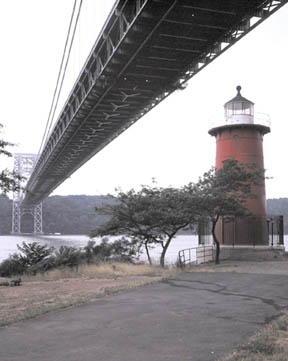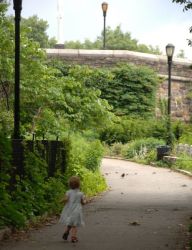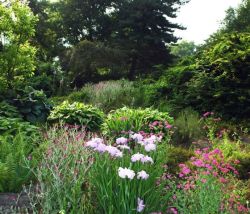Fort Tryon Park
The Daily Plant : Thursday, April 3, 2003
ASK PROFESSOR GINKGO: LIGHTS, WATER, ACTION!

Professor Ginkgo,
The Little Red Lighthouse-- why is the light in the lighthouse no longer shining? I recall that in September 2002 we celebrated the restoration of its light. My second question regards the rocks outside of the Cloisters in Fort Tryon Park-- I noticed signs of water along the rock outcroppings in Fort Tryon Park. It had been a few days since it had rained and I could not find a source from whither the water could come. Professor, why do the rock outcroppings appear to be producing water?
Well, young investigator, you’re correct that this past fall Parks & Recreation and the Historic House Trust marked the 10th Annual Little Red Lighthouse Festival by returning light to the great little monument. However, I am happy to report that its light still shines.The lighthouse hasn’t always been where it now stands. In 1880, a forty-foot tall lighthouse was born in Sandy Hook, New Jersey. Named "the North Hook Beacon" and constructed of 48 cast-iron plates, the lighthouse was a small-scale version of many others built in the 19th century. It remained there until 1917 when it was taken apart because it stood in the line of fire of Fort Hancock’s gun battery.
In 1921, the Little Red Lighthouse was put back together again at Fort Washington Park to help navigate boats along the Hudson River. In 1942, Hildegarde Swift wrote the now famous children’s book entitled The Little Red Lighthouse and the Great Gray Bridge, and a generation of children fell in love with the little beacon. The completion of the George Washington Bridge, however, ultimately made the lighthouse unnecessary (for navigational purposes, at least). In 1947, the U.S. Coast Guard decommissioned the lighthouse and made plans for its sale.
A national children’s letter writing campaign ultimately saved the lighthouse, and on July 23, 1951, the Coast Guard donated the Little Red Lighthouse to the City. It was added to the National Register of Historic Places and placed under the care of the Historic House Trust in 1996. It was restored to its old glory in 2000.
Now, on to the story of its light—which is almost as unusual as the lighthouse itself. Its original sequence was 1 second on, 2 seconds off. When it was reconstructed in 1921, it was equipped with a 100-candlepower acetylene flashing red lamp, part of a fifth order Fresnel lens. Its sequence was 1 second on, 3 seconds off.
When it was decommissioned, the lighthouse was stripped of this light. Wanting to rekindle its old spark, the Historic House Trust had added Little Red’s name to the Coast Guard’s waiting list for Fresnel lenses. In September 2001, the Coast Guard was able to grant its request, having located a 300mm electric-powered fresnel (lower case 'f'). Although it was not the exact type of lens originally in Little Red, the light was a very close match.
The lens was installed in the lighthouse in anticipation of last September’s festival. Originally, the Historic House Trust tested a light-sensitive switch for the light to operate on. When the George Washington Bridge was given new lighting, however, its brightness prevented the sensor from working properly. Ultimately a system was put in place that works on a timer. Every day from 6:00 p.m. until 6:00 a.m., the Little Red Lighthouse flashes in its original sequence, 1 second on, 2 seconds off.
The light was never bright—it’s as true to the original as possible—so it’s best viewed on a clear night from the Hudson. But the light is on, and I invite you to check it out again for yourself and you’ll seen.
And on to the second question….ah, another great one. The water you see is not magic—although nature itself is certainly magical. What you’ve witnessed in this beautiful park is simply water that has been contained in the soil all winter as ice. As the soil heats up in springtime, water flows out of the soil—especially after storms—and you will see it weeping down bedrock . All this excess water comes thanks to the snow and ice we’ve had this year, so it might seem like there’s more water coming out of the soil than usual. It’s something that’s occurred since the Weckquaesgeek Tribe inhabited the area over four centuries ago.
Thanks for writing.
QUOTATION FOR THE DAY
"A sharp tongue is the only edged tool that grows keener with constant use."
Washington Irving
(April 3, 1783-1859)
Check out your park's Vital Signs
Clean & Safe
Green & Resilient
Empowered & Engaged Users
Share your feedback or learn more about how this park is part of a
Vital Park System









